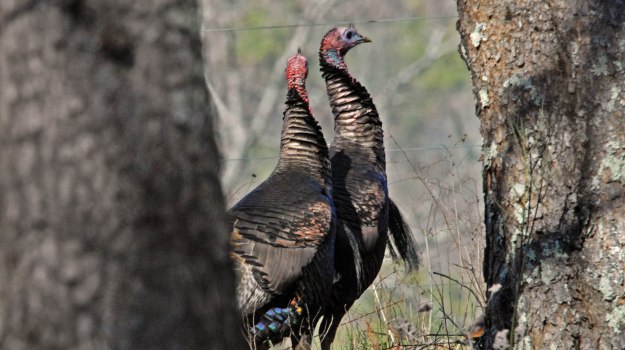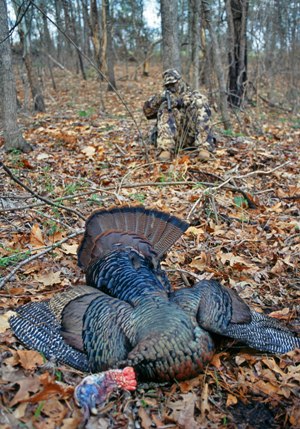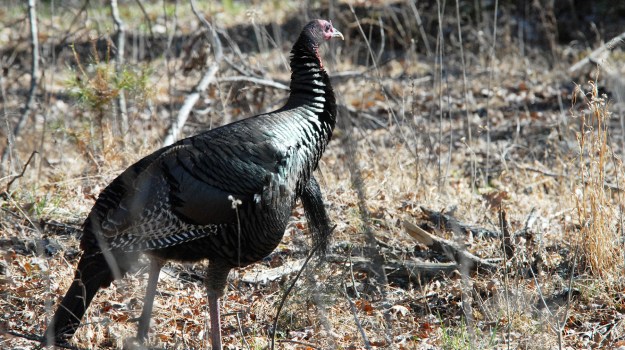
Editor’s Note: Bucky Hauser of Virginia is a member of Mossy Oak’s Pro Staff and has been hunting turkeys for 25 years. This week we asked Bucky to give us five tips that will help us take turkeys this season.
Many hunters don’t realize how still you have to be when you’re turkey hunting. Most hunters don’t consider where the turkey’s eyes are located on his head. A turkey’s eyes are on the side of his head – not on the front of his head like our eyes. We can see straight ahead, but we don’t have very-good peripheral vision. A turkey has 180-degree eyesight in each of his eyes and can spot the slightest bit of movement off to the side of him as well as in front of him. If you’ve noticed, when a turkey really starts looking at something, he’ll cock his head to the side and more or less look to one side. Then he’ll turn his head the other way and look with the other eye, so he can see everything all the way around him, to pick up any movement that is within his vision.
If you’re a fisherman, you know that sonar has changed dramatically. Our depth finders used to show us what was directly underneath our boats. If you passed by something just out of the cone angle of your depth finder, you couldn’t see it. However, with the new side-scanning depth finders, you can see not only down, but everything on the left and the right sides of the boat. And, that’s the difference in a hunter’s eyesight and a turkey’s eyesight. The hunter can see what’s in front of him. The gobbler can see everything around him, and that’s the reason you have to keep your movement to a minimum and wear camouflage.
 The turkey knows that there are thermals and different types of winds in the outdoors. It understands that sometimes the wind will blow in one area of the woods but not in another area. The bird realizes that if a strong wind is blowing, then all the bushes and trees will be moving at the same time. But if there’s only a slight breeze, some bushes may move but others may not. If you’re wearing full Mossy Oak camouflage, you can get away with some movement.
The turkey knows that there are thermals and different types of winds in the outdoors. It understands that sometimes the wind will blow in one area of the woods but not in another area. The bird realizes that if a strong wind is blowing, then all the bushes and trees will be moving at the same time. But if there’s only a slight breeze, some bushes may move but others may not. If you’re wearing full Mossy Oak camouflage, you can get away with some movement.
During the spring, I wear two different patterns – Mossy Oak Break-Up Infinity and Mossy Oak Obsession. Break-Up Infinity has the darker colors, and Obsession features the greener colors. At the first of turkey season in Virginia, the woods aren’t fully green. Most of the woods still have those darker tones like you see in Mossy Oak Break-Up. So, I wear Break-Up the first 2 weeks of the season. Then as the woods become greener, I wear Mossy Oak Obsession. For me, camouflage needs to match the woods at the time of the year and the area where I’m hunting. Break-Up is a more-open pattern and has more of the blacks, browns and grays in it. I don’t think you can beat this pattern for early-season turkey hunting. Obsession has more of the greens and blends in better as the woods become greener. I’m convinced that matching the colors of my camo to the colors the turkey is seeing in the woods helps me stay hidden better. I know that different hunters have various ideas about camouflage, and some hunters will wear the same camo pattern during the entire season. But with these two patterns, I can successfully hunt early and late turkey season. When deer season comes in, especially bow season, I can use Obsession during the early season and Break-Up later in the season.
Tip #1 - Don’t Let the Turkeys Smell You during Early Season Scouting for Turkeys
Tomorrow: Tip #3 – Go High for Gobblers






























